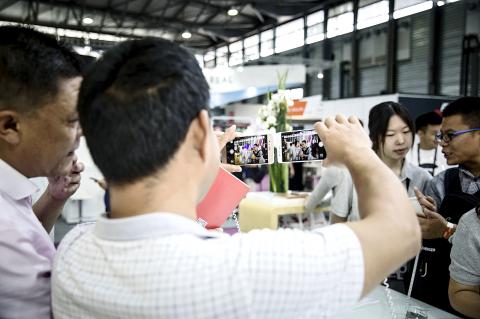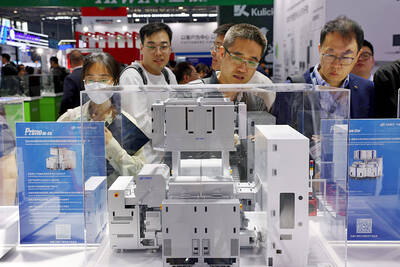The global launch of the iPhone 7 yesterday is crucial to Apple Inc’s fortunes in China, but both it and its biggest rival, Samsung Electronics Co, hit by a recall over exploding batteries, are struggling in the face of upstart local competitors.
The US and South Korean firms were relegated to fourth and fifth place respectively in the Asian giant’s smartphone market in the first half of this year, according to consultancy Canalys.
Ahead of them came three Chinese firms, leader Huawei Technologies Co (華為) with a 16 percent share, then two companies little known elsewhere, Vivo Communication Technology Co Ltd (維沃移動通信) and Oppo Mobile Telecommunications Corp (歐珀移動).

Photo: Bloomberg
Apple faces “a lot of challenges and pressures” in China from local manufacturers who are “developing medium to high-end handsets and offer a lot of flagship products,” Canalys China analyst Jessie Ding (丁婕) said.
The iPhone 7 — which comes with an improved camera, a water-resistant body and minus an earphone jack — “doesn’t have many innovative features,” she said, adding that its double camera function was available on a Huawei smartphone six months ago and it lacks wireless charging capabilities.
In its most recent quarterly results, Apple said Greater China dropped from second to third place among its markets in the April-to-June period — when market research firm IDC says its iPhone sales collapsed by 32 percent year-on-year.
For its part, Samsung has had to recall 2.5 million of its flagship Galaxy Note 7 handsets after faulty batteries caused some to explode during charging.
The company has handled the issue badly, said Neil Mawston of Strategy Analytics, with slow decisionmaking, poor communications and a lack of coordination, and its image risks suffering.
“Brand loyalty is not as strong in China as in other markets,” he told reporters. “It’s a very crowded, fragmented market and fiercely competitive, with rivals undercutting each other with price and design. So it’s not a market you can afford to falter in.”
Low-priced Chinese competitors have been “particularly troublesome” for Samsung, which has in the past sought to offer phones across all price ranges, he added.
Samsung has responded by trying to focus on the mid and high-end sector with improved models, which could make the recall especially damaging.
And now “the Chinese companies are producing higher-end smartphones as well — and with a large degree of success,” he said. “In the last three or four years, local Chinese brands have been on a roll, fueled by a swell of national pride in ‘brand China.’”
Chinese manufacturers’ great advantage remains price: Huawei’s P9 boasts similar capabilities to the iPhone 7, but is almost a third cheaper.
There is no official ranking of smartphone sales in China and several different consultancies put out figures.
Oppo — an unknown in the West — has experienced a meteoric rise since it launched in 2011.
According to Counterpoint Research, it became China’s No. 1 smartphone brand in June, when its market share jumped to 23 percent.
It is aiming squarely for the low end of the market.
“Oppo has adopted a simple but effective strategy, going after the offline market ... using aggressive marketing, promotions and sponsorships ... beyond tier-2 and tier-3 cities,” said Counterpoint Research director Neil Shah.
Vivo, part of BKK Electronics Corp (步步高電子), the same conglomerate that owns Oppo — employs similar methods, investing heavily in marketing to build up its brand image and on a vast distribution network that extends to China’s smaller and poorer cities and towns.
Analysts said Apple still benefits from its luxury image and the strong loyalty of its long-time users in China, but the Californian firm sometimes has to contend with the Chinese Communist Party authorities and the firm has sometimes been targeted by state-owned Chinese media on issues of customer service.
More broadly, “Samsung — and Apple — face similar challenges in China,” Mawston said.
“There are serious distribution challenges, the fact that Chinese consumers tend to favor Chinese brands, as well as Chinese-language software that links well with Chinese social networks,” he said.

SEMICONDUCTOR SERVICES: A company executive said that Taiwanese firms must think about how to participate in global supply chains and lift their competitiveness Taiwan Semiconductor Manufacturing Co (TSMC, 台積電) yesterday said it expects to launch its first multifunctional service center in Pingtung County in the middle of 2027, in a bid to foster a resilient high-tech facility construction ecosystem. TSMC broached the idea of creating a center two or three years ago when it started building new manufacturing capacity in the US and Japan, the company said. The center, dubbed an “ecosystem park,” would assist local manufacturing facility construction partners to upgrade their capabilities and secure more deals from other global chipmakers such as Intel Corp, Micron Technology Inc and Infineon Technologies AG, TSMC said. It

EXPORT GROWTH: The AI boom has shortened chip cycles to just one year, putting pressure on chipmakers to accelerate development and expand packaging capacity Developing a localized supply chain for advanced packaging equipment is critical for keeping pace with customers’ increasingly shrinking time-to-market cycles for new artificial intelligence (AI) chips, Taiwan Semiconductor Manufacturing Co (TSMC, 台積電) said yesterday. Spurred on by the AI revolution, customers are accelerating product upgrades to nearly every year, compared with the two to three-year development cadence in the past, TSMC vice president of advanced packaging technology and service Jun He (何軍) said at a 3D IC Global Summit organized by SEMI in Taipei. These shortened cycles put heavy pressure on chipmakers, as the entire process — from chip design to mass

Germany is to establish its first-ever national pavilion at Semicon Taiwan, which starts tomorrow in Taipei, as the country looks to raise its profile and deepen semiconductor ties with Taiwan as global chip demand accelerates. Martin Mayer, a semiconductor investment expert at Germany Trade & Invest (GTAI), Germany’s international economic promotion agency, said before leaving for Taiwan that the nation is a crucial partner in developing Germany’s semiconductor ecosystem. Germany’s debut at the international semiconductor exhibition in Taipei aims to “show presence” and signal its commitment to semiconductors, while building trust with Taiwanese companies, government and industry associations, he said. “The best outcome

Semiconductor equipment billings in Taiwan are expected to double this year, as manufacturers in the industry are keen to expand production to meet strong global demand for artificial intelligence applications, according to SEMI, which represents companies in the electronics manufacturing and design supply chain. Speaking at a news conference before the opening of Semicon Taiwan trade show tomorrow, SEMI director of industry research and statistics Clark Tseng (曾瑞榆) said semiconductor equipment billings in Taiwan are expected to grow by an annual 100 percent this year, beating an earlier estimate of 70 percent growth. He said that Taiwan received a boost from a